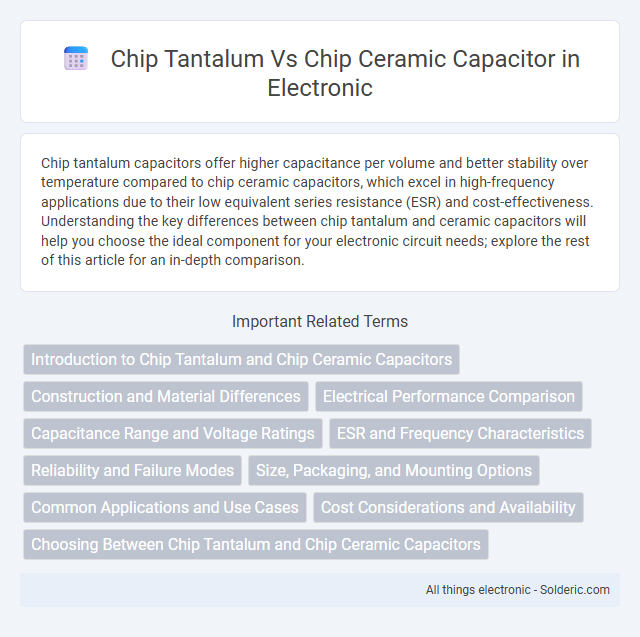Chip tantalum capacitors offer higher capacitance per volume and better stability over temperature compared to chip ceramic capacitors, which excel in high-frequency applications due to their low equivalent series resistance (ESR) and cost-effectiveness. Understanding the key differences between chip tantalum and ceramic capacitors will help you choose the ideal component for your electronic circuit needs; explore the rest of this article for an in-depth comparison.
Comparison Table
| Feature | Chip Tantalum Capacitor | Chip Ceramic Capacitor |
|---|---|---|
| Material | Tantalum metal powder | Barium titanate or other ceramic compounds |
| Capacitance Range | 0.1 uF to 470 uF | 1 pF to 100 uF |
| Voltage Rating | 2V to 50V typical | 6.3V to 500V typical |
| Size | Generally larger due to higher capacitance | Smaller sizes, suitable for compact designs |
| Equivalent Series Resistance (ESR) | Low ESR, suitable for power applications | Very low ESR, better for high-frequency circuits |
| Polarization | Polarized capacitors | Non-polarized capacitors |
| Temperature Stability | Moderate stability; sensitive to higher temperatures | High stability; varies by ceramic class (e.g., C0G, X7R) |
| Cost | Higher cost per capacitance unit | Generally lower cost |
| Typical Applications | Power supply filtering, decoupling in low-frequency circuits | High-frequency filtering, decoupling, RF circuits |
| Failure Mode | Can short-circuit on failure | Open circuit on failure |
Introduction to Chip Tantalum and Chip Ceramic Capacitors
Chip tantalum capacitors offer high capacitance values and stable performance in small packages, making them ideal for power supply filtering and decoupling applications. Chip ceramic capacitors provide excellent high-frequency characteristics, low equivalent series resistance (ESR), and superior reliability in surface-mount technology (SMT) designs. Your choice between these capacitors depends on factors like voltage rating, capacitance, size constraints, and the operating environment.
Construction and Material Differences
Chip tantalum capacitors use a tantalum metal anode with a solid manganese dioxide or polymer electrolyte, offering high capacitance in a small volume. Chip ceramic capacitors consist of multiple layers of ceramic dielectric material with metal electrodes, providing excellent frequency response and stability. Your choice depends on the need for high capacitance and stable performance versus low ESR and high-frequency applications.
Electrical Performance Comparison
Chip tantalum capacitors offer higher capacitance per volume and lower equivalent series resistance (ESR), making them ideal for filtering and decoupling in low-frequency circuits. Chip ceramic capacitors exhibit superior high-frequency performance and stability due to their low dielectric losses and better temperature characteristics. Both capacitor types demonstrate distinct electrical advantages that influence selection based on frequency response and application requirements.
Capacitance Range and Voltage Ratings
Chip tantalum capacitors typically offer capacitance values ranging from 0.1uF to 470uF with voltage ratings between 4V and 50V, making them suitable for stable, high-capacitance applications in compact spaces. Chip ceramic capacitors provide a broader capacitance range from a few picofarads to 100uF and support higher voltage ratings up to 100V or more, ideal for high-frequency and high-voltage circuits. The selection depends on the required capacitance stability, voltage tolerance, and application-specific performance criteria.
ESR and Frequency Characteristics
Chip tantalum capacitors exhibit lower Equivalent Series Resistance (ESR) compared to chip ceramic capacitors, making them ideal for applications requiring stable performance at lower frequencies. Chip ceramic capacitors, especially those using Class II or III dielectric materials, perform better at higher frequencies due to their lower inductance and superior frequency characteristics. The choice between chip tantalum and ceramic capacitors depends on the specific ESR requirements and the operational frequency range in power supply decoupling or signal filtering applications.
Reliability and Failure Modes
Chip tantalum capacitors exhibit higher reliability in stable environments but are susceptible to catastrophic failure due to dielectric breakdown, often caused by excessive voltage or surge currents. Chip ceramic capacitors demonstrate excellent resistance to mechanical stress and thermal cycling, with failure modes typically related to cracking or insulation degradation over time. Both capacitor types require careful consideration of application conditions to optimize lifespan and minimize failure risks.
Size, Packaging, and Mounting Options
Chip tantalum capacitors generally offer higher capacitance values in smaller sizes compared to chip ceramic capacitors, making them ideal for space-constrained applications. Tantalum capacitors come in molded or epoxy-coated packaging, enhancing durability and protection, while ceramic capacitors are typically available in multilayer ceramic packages that support higher frequency performance. Both types support surface-mount technology (SMT), with chip tantalum capacitors commonly used in B or C case sizes, and ceramic capacitors available across a broader range of compact sizes such as 0201, 0402, and 0603 for versatile mounting options.
Common Applications and Use Cases
Chip tantalum capacitors excel in applications requiring stable capacitance and high volumetric efficiency, such as in power supply filtering, audio equipment, and aerospace electronics. Chip ceramic capacitors are widely used for high-frequency decoupling, noise suppression, and timing circuits in smartphones, computers, and automotive control systems. Your choice depends on the specific requirements of stability, capacitance value, and operating environment in your electronic design.
Cost Considerations and Availability
Chip ceramic capacitors generally offer lower costs and higher availability due to their widespread manufacturing and use in various electronic applications. Tantalum chip capacitors tend to be more expensive, influenced by the cost of tantalum metal and specialized production processes, which can also result in limited stock availability. Budget-sensitive projects with high-volume demand often favor ceramic capacitors for economic advantages and supply consistency.
Choosing Between Chip Tantalum and Chip Ceramic Capacitors
Choosing between chip tantalum and chip ceramic capacitors depends on factors such as capacitance value, voltage rating, and application stability. Chip tantalum capacitors offer higher capacitance per volume and better performance at low frequencies, making them ideal for power supply filtering, while chip ceramic capacitors excel in high-frequency applications due to low equivalent series resistance (ESR) and improved thermal stability. Evaluating circuit requirements for size constraints, frequency response, and reliability will guide optimal capacitor selection in electronic designs.
Chip tantalum vs chip ceramic capacitor Infographic

 solderic.com
solderic.com